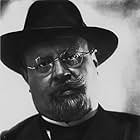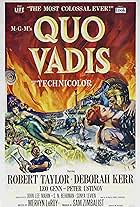This film (one I had given up for lost but which is actually readily accessible now – in nine separate installments – on "You Tube"!) is a testament to the development of early cinema from one decade to the next. While the 1912 version of this historical spectacle (watched a couple of days previously) today comes across as very primitive, in both cinematic technique and acting style, this shows considerable refinement in most aspects of production – emerging a fairly accomplished epic that can be seen to have influenced Cecil B. De Mille's THE SIGN OF THE CROSS (1932; which followed an almost identical plot line while sharing with it some of its leading characters!). The latter film is noted for its Pre-Code emphasis on brutality and eroticism; these elements, to a lesser extent, are also present even here (with, for instance, a couple of Nero's undesired minions being fed alive to his flesh-eating eels in the very first scene!). That said, apart from the obvious dominance of the great German star Emil Jannings (as Nero, who really takes center-stage here), the rest of the characters still receive underwhelming interpretations (with the biggest liability in this case being the rather fey hero Vinicius and his severely underwritten romantic interest Lygia!) – especially in comparison with the definitive 1951 Hollywood rendition (running almost twice as much as both previous adaptations!). Nevertheless, the essence of the tale is very much here (with even some figures, like the slimy Chilonedes, I had completely forgotten about from viewings of the later version{s} – which, to be fair, it has been some 20 odd years since). However, as with many of these solemn efforts, the plot begins to bore well before the end – given a central romance fraught with cliff-hanging situations at every turn, or it may simply be that I watched both Silents in too close a proximity! There are, however, a number of 'new' scenes involving Nero: the death of his son (mentioned but not seen in the 1912 film), his consulting with a mediumistic old hag and his own lecherous intentions on the heroine – which, given his frizzy hairdo and penchant for harp-playing, one could liken Jannings to a bloated version of Harpo Marx! The film's centerpiece, depicting the burning of Rome, is quite well done but, then, the climax in the arena (lions feasting on Christians and Lygia's burly protector Ursus – played by the same actor as the earlier adaptation! – battling a bull) still feels somewhat rushed. Bafflingly, rather than Miklos Rozsa's score for the 1951 QUO VADIS, the musical accompaniment for the copy I watched of the film under review unofficially borrowed several cues from the same composer's legendary work for another much-filmed spectacular about Ancient Rome i.e. BEN-HUR (1959) – albeit giving them an electronic makeover by being played on a synthesizer! For the record, although I have acquired a handful of other rare Silent epics – CABIRIA (1914), NATHAN THE WISE (1922), SODOM AND GOMORRAH (1922), SALOME' (1923), the two-part HELENA (1924), etc. – these will have to await their turn until next year's Holy Week (at the very least)...































